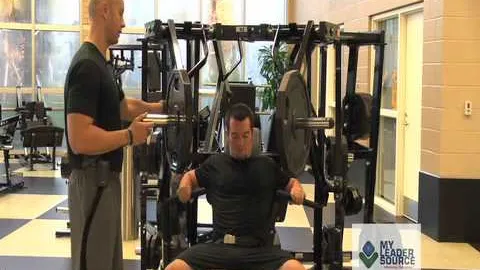
The isolateral decline chest press is a highly effective exercise that targets the lower chest muscles. It is a variation of the traditional decline chest press, but with the added benefit of isolating and working each side of the chest independently. In this article, we will guide you through the proper technique, benefits, and variations of the isolateral decline chest press.
Setup: Begin by adjusting the decline bench to an appropriate angle. Position yourself on the bench with your feet flat on the ground and your back firmly pressed against the bench. Grasp the handles or dumbbells, ensuring your palms are facing forward and your elbows are at a 90-degree angle.
Execution: Slowly push the handles or dumbbells away from your body, extending your arms fully while maintaining control. As you lower the weight, focus on the stretch in your chest muscles. Avoid locking out your elbows at the top of the movement to keep the tension on the muscles. Repeat for the desired number of repetitions.
Breathing: Breathe out as you push the weight away from your body, and breathe in as you lower the weight back to the starting position. Maintain a steady breathing pattern throughout the exercise.
Tips: Keep your core engaged and your back firmly pressed against the bench throughout the exercise. Avoid arching your back or using excessive momentum to lift the weight. Maintain proper form and alignment to maximize the effectiveness of the exercise.
The isolateral decline chest press offers several benefits that can enhance your overall strength and physique:
Strengthening the lower chest: The primary target of this exercise is the lower pectoral muscles. By isolating and working each side independently, you can effectively develop and strengthen this area, leading to a more balanced and defined chest.
Increasing muscle activation: By using dumbbells or handles instead of a barbell, the isolateral decline chest press requires each side of your chest to engage independently. This increased muscle activation can help you overcome strength imbalances and boost overall muscle development.
Improving stability and balance: Performing the isolateral decline chest press requires stability and balance, as you need to control each side separately. This can lead to improved muscle coordination and balance, reducing the risk of injuries in other activities or sports.
Enhancing overall chest development: Adding the isolateral decline chest press to your workout routine helps in building a well-rounded chest. While the exercise primarily targets the lower chest, it also engages the upper and middle chest muscles, resulting in overall chest development.
Variety and progression: The isolateral decline chest press offers numerous variations and progression options. You can adjust the weight, angle of the bench, or use different equipment like resistance bands to challenge yourself and continue making progress.
Single-arm isolateral decline chest press: Instead of using both hands simultaneously, perform the exercise with one arm at a time. This variation adds an extra challenge to your muscles and further improves stability and balance.
Resistance band isolateral decline chest press: Attach resistance bands to the handles or anchors and perform the exercise with them. The resistance bands provide variable resistance throughout the movement, demanding more from your muscles and increasing the overall difficulty.
Machine-based isolateral decline chest press: If you have access to a machine that allows isolateral chest pressing, you can use it to perform the exercise. The guided motion can be beneficial for beginners or those focusing on controlled movements.
The isolateral decline chest press is an effective exercise for targeting the lower chest muscles. By incorporating this exercise into your routine, you can strengthen your chest, improve muscle activation, enhance stability and balance, and achieve overall chest development. Remember to maintain proper form and gradually increase the weights or resistance to continue challenging your muscles. Now that you have learned the technique, benefits, and variations of the isolateral decline chest press, it's time to hit the gym and put this knowledge into action!
If you're looking for a gym, fitness club or yoga studio, you've come to the right place.
You can find information about gyms in your area. Browse catalog of gyms and find gyms with classes which are you looking for.
On gym page you can find simple information like address, phone or website. You can find list of available classes. You can check availability of personal training or small group classes. On place page you can also see information about open hours.
You can find gyms near you with amenities, courts, studios and equipments.
Use our map to find gym at your city or district.
In Gym Navigator you can find list of exercises with movies for many body parts.
You can browse exercises catalog and find exercises the best of you.
You can also find exercises grouped into workout plans, which you can use to improve you body. Each routine show you exercises one by one and give you possibility to count you progress and count down rest time.